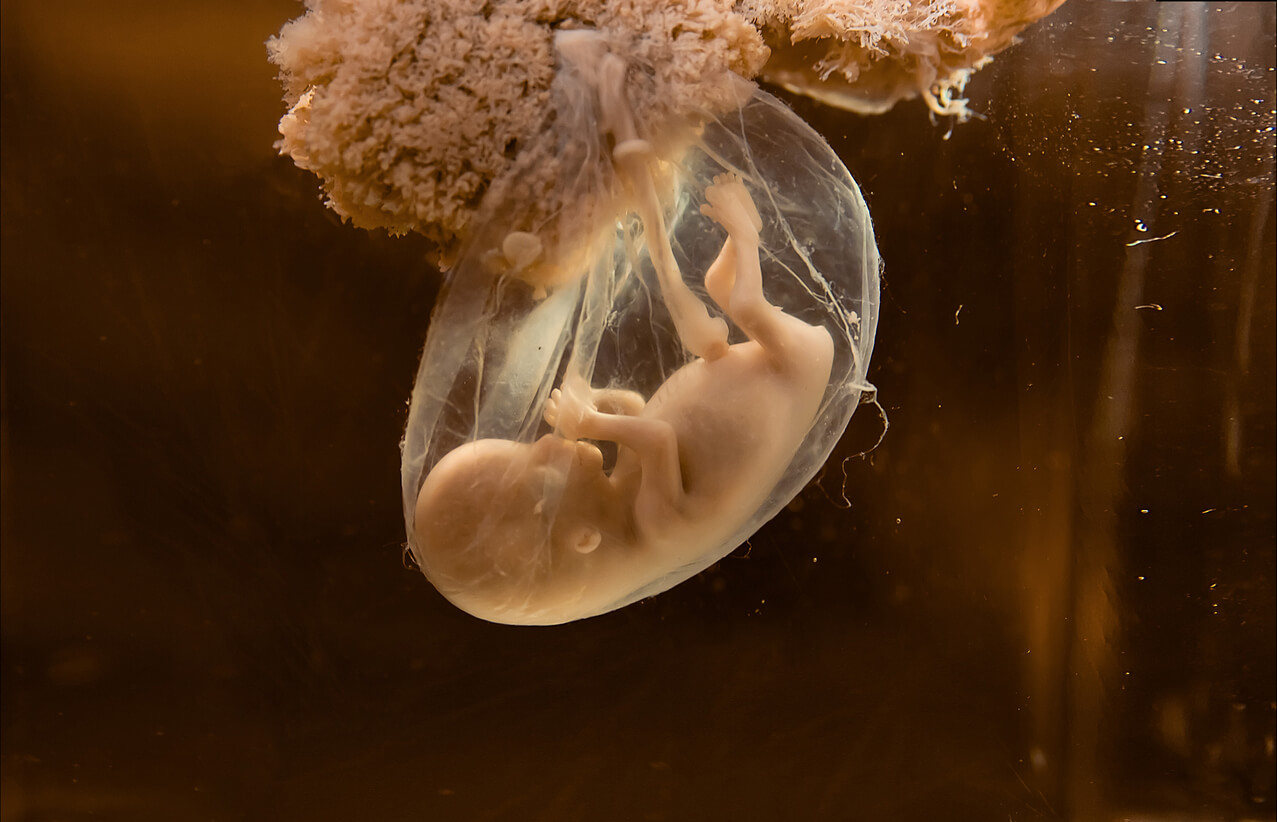Fissures in the Amniotic Sac: Everything You Need to Know


Written and verified by the nurse Leidy Mora Molina
The amniotic sac is a placental membrane located inside the uterus, which contains the liquid in which the baby swims. Under normal conditions, this sac ruptures during labor, although sometimes it can rupture prematurely and increase risks to the health of the mother and the baby. In this article, we’ll tell you everything you need to know about fissures in the amniotic sac during pregnancy.
Fissures in the amniotic sac
Babies develop inside the mother’s womb within a flexible and hermetically sealed membrane. This is called the amniotic sac, as it’s like a thin-walled bag that contains the fluid with the same name. The main function of this structure is to protect the baby until birth.
In this sense, this bag keeps little ones away from harmful germs, at a suitable temperature, favors their free movement, and prevents injuries from sudden blows from the outside.
Under certain conditions, this membrane can fissure or rupture before delivery arrives, which favors the loss of amniotic fluid. This can negatively affect the pregnancy, bringing complications such as miscarriage, premature births, or low birth weight in babies.
These small fissures in the amniotic sac usually occur within weeks of delivery, with minimal fluid loss that can be controlled with proper treatment and rest.
However, ruptures that occur in the earliest stages of pregnancy can involve an enormous risk for the baby.

The causes of fissures in the amniotic sac
There are some maternal health conditions that can lead to this membrane cracking or rupturing prematurely. Among the most common, we can highlight the following:
- Cervical infections: Infections in the vaginal area favor the colonization of germs in the walls of the bag and this causes them to weaken and crack.
- Increased intrauterine pressure, either due to polyhydramnios or multiple pregnancies.
- Diagnostic tests that require the puncture of the amniotic sac, such as amniocentesis.
- Maternal abdominal trauma or falls.
- True uterine contractions.
- Alterations in pregnancy, such as premature abruption of the placenta, congenital anomalies, and fetal growth retardation.
- Maternal history of fissures in the amniotic sac. There’s a greater predisposition to fissures in the amniotic sac if it has already happened in previous pregnancies.
- Poor maternal habits regarding food or the consumption of toxins (cigarettes or drugs).
How do I know if I have a fissure in the amniotic sac?
To know if you have a fissure in the amniotic sac, it’s essential to corroborate that you have a loss of amniotic fluid. This fluid is light in color, almost transparent, and odorless, much like water.
Occasionally, these amniotic fluid leaks can be confused with vaginal discharge or urine, so it’s important to assess the differential characteristics of these leaks.
First of all, when there’s a fissure in the amniotic sac, you have the sensation of having wet underwear during the day. In addition, this discomfort increases when walking or making any physical effort. If this is the case, keep the following points in mind:
- Observe what this secretion is like, its consistency, and its smell. Differentiate it from vaginal discharge (thicker and whitish) and from urine (which has an odor).
- If you’re still in doubt, empty your bladder and put on new underwear or a sanitary pad. Then make some effort (such as coughing or walking) and see if you get wet again. If so, it’s very likely that you have a fissure in the amniotic sac.
- Use some home tests to detect amniotic fluid leaks. These are available at pharmacies and come in the form of a sanitary pad, with a test strip that measures the pH of vaginal secretions. Amniotic fluid has a high pH and turns the dressing blue or green. If this happens, go to the hospital as soon as possible.

Should I go to the specialist if I have a fissure in the amniotic sac?
If you feel any pelvic discomfort or if you suspect that you’re leaking amniotic fluid, contact your treating doctor. The specialist will perform a gynecological examination and an ultrasound in order to assess the conditions of the cervix and the amount of remaining fluid. In addition to determining the loss, they’ll assess the baby’s condition and uterine conditions.
If the fissure in the amniotic sac is verified, the doctor will probably prescribe rest to replace the lost fluid and antibiotic treatment to prevent an intra-amniotic infection, as this is one of the main undesired consequences of this problem.
Be attentive to the appearance of certain symptoms, such as changes in the color of the secretions, bad smell, or blood. Also, pay attention to the cessation or an abrupt decrease in the baby’s movements. All this could indicate an emergency and you should go to the hospital as soon as possible.
If the amount of amniotic fluid is very low, a specialist will be able to evaluate the possibility of inducing the birth in order to avoid risking the life of the baby.
The amniotic sac is a placental membrane located inside the uterus, which contains the liquid in which the baby swims. Under normal conditions, this sac ruptures during labor, although sometimes it can rupture prematurely and increase risks to the health of the mother and the baby. In this article, we’ll tell you everything you need to know about fissures in the amniotic sac during pregnancy.
Fissures in the amniotic sac
Babies develop inside the mother’s womb within a flexible and hermetically sealed membrane. This is called the amniotic sac, as it’s like a thin-walled bag that contains the fluid with the same name. The main function of this structure is to protect the baby until birth.
In this sense, this bag keeps little ones away from harmful germs, at a suitable temperature, favors their free movement, and prevents injuries from sudden blows from the outside.
Under certain conditions, this membrane can fissure or rupture before delivery arrives, which favors the loss of amniotic fluid. This can negatively affect the pregnancy, bringing complications such as miscarriage, premature births, or low birth weight in babies.
These small fissures in the amniotic sac usually occur within weeks of delivery, with minimal fluid loss that can be controlled with proper treatment and rest.
However, ruptures that occur in the earliest stages of pregnancy can involve an enormous risk for the baby.

The causes of fissures in the amniotic sac
There are some maternal health conditions that can lead to this membrane cracking or rupturing prematurely. Among the most common, we can highlight the following:
- Cervical infections: Infections in the vaginal area favor the colonization of germs in the walls of the bag and this causes them to weaken and crack.
- Increased intrauterine pressure, either due to polyhydramnios or multiple pregnancies.
- Diagnostic tests that require the puncture of the amniotic sac, such as amniocentesis.
- Maternal abdominal trauma or falls.
- True uterine contractions.
- Alterations in pregnancy, such as premature abruption of the placenta, congenital anomalies, and fetal growth retardation.
- Maternal history of fissures in the amniotic sac. There’s a greater predisposition to fissures in the amniotic sac if it has already happened in previous pregnancies.
- Poor maternal habits regarding food or the consumption of toxins (cigarettes or drugs).
How do I know if I have a fissure in the amniotic sac?
To know if you have a fissure in the amniotic sac, it’s essential to corroborate that you have a loss of amniotic fluid. This fluid is light in color, almost transparent, and odorless, much like water.
Occasionally, these amniotic fluid leaks can be confused with vaginal discharge or urine, so it’s important to assess the differential characteristics of these leaks.
First of all, when there’s a fissure in the amniotic sac, you have the sensation of having wet underwear during the day. In addition, this discomfort increases when walking or making any physical effort. If this is the case, keep the following points in mind:
- Observe what this secretion is like, its consistency, and its smell. Differentiate it from vaginal discharge (thicker and whitish) and from urine (which has an odor).
- If you’re still in doubt, empty your bladder and put on new underwear or a sanitary pad. Then make some effort (such as coughing or walking) and see if you get wet again. If so, it’s very likely that you have a fissure in the amniotic sac.
- Use some home tests to detect amniotic fluid leaks. These are available at pharmacies and come in the form of a sanitary pad, with a test strip that measures the pH of vaginal secretions. Amniotic fluid has a high pH and turns the dressing blue or green. If this happens, go to the hospital as soon as possible.

Should I go to the specialist if I have a fissure in the amniotic sac?
If you feel any pelvic discomfort or if you suspect that you’re leaking amniotic fluid, contact your treating doctor. The specialist will perform a gynecological examination and an ultrasound in order to assess the conditions of the cervix and the amount of remaining fluid. In addition to determining the loss, they’ll assess the baby’s condition and uterine conditions.
If the fissure in the amniotic sac is verified, the doctor will probably prescribe rest to replace the lost fluid and antibiotic treatment to prevent an intra-amniotic infection, as this is one of the main undesired consequences of this problem.
Be attentive to the appearance of certain symptoms, such as changes in the color of the secretions, bad smell, or blood. Also, pay attention to the cessation or an abrupt decrease in the baby’s movements. All this could indicate an emergency and you should go to the hospital as soon as possible.
If the amount of amniotic fluid is very low, a specialist will be able to evaluate the possibility of inducing the birth in order to avoid risking the life of the baby.
All cited sources were thoroughly reviewed by our team to ensure their quality, reliability, currency, and validity. The bibliography of this article was considered reliable and of academic or scientific accuracy.
- Morgan F, Quevedo E, Gutiérrez J. (2015) Anatomía y fisiología de la placenta y líquido amniótico. Revista MEDUAS; Vol.5 Nº4.
- Pradenas, M.(2014). Infecciones cérvico vaginales y embarazo. Revista Médica Clínica Las Condes. Vol. 25. Núm. 6. Pp. 925-935
- Orias, M (2020). Ruptura prematura de membranas. Revista medica sinergia. Vol. 5. Nº22. Recuperado de: https://revistamedicasinergia.com/index.php/rms/article/view/606
- The American College of Obstetricians and Gynecologists. (2020). Ruptura de membranas antes del trabajo de Parto. Recuperado de: https://www.acog.org/clinical/clinical-guidance/practice-bulletin/articles/2020/03/prelabor-rupture-of-membranes
This text is provided for informational purposes only and does not replace consultation with a professional. If in doubt, consult your specialist.








